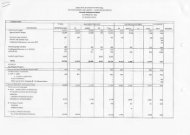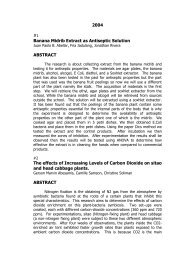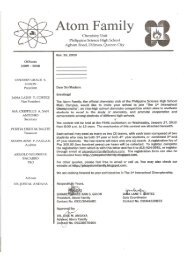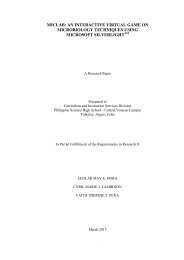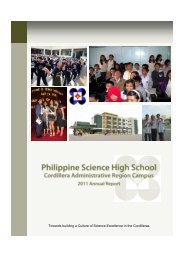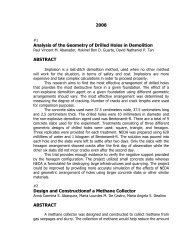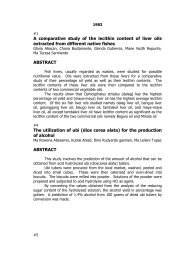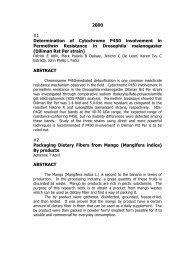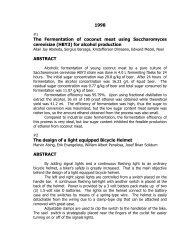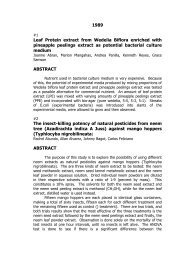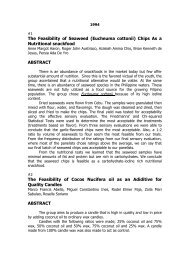A comparative study of paper produced from zea mays - Philippine ...
A comparative study of paper produced from zea mays - Philippine ...
A comparative study of paper produced from zea mays - Philippine ...
You also want an ePaper? Increase the reach of your titles
YUMPU automatically turns print PDFs into web optimized ePapers that Google loves.
#28<br />
The device to harness th mechanical energy released<br />
during the deceleration <strong>of</strong> an automobile<br />
Giselle G Gervacio, Elma S Dizon, Yvonne R Pineda, Emmeline G Cadabes,<br />
Geneva M Selirio<br />
ABSTRACT<br />
The <strong>study</strong> deals with the construction <strong>of</strong> a fuel economizer which<br />
works by reutilizing the harnesses mechanical energy released during the<br />
deceleration <strong>of</strong> an automobile. The principal parts <strong>of</strong> the device are: an<br />
alternator which converts mechanical energy to electrical energy, a DC source<br />
which stores the generated energy, and a DC motor which reconverts the<br />
electrical energy into mechanical energy. Consequently, the device helps the<br />
engine propel the vehicle, thereby lessening the engine’s load.<br />
Efficiency tests conducted to compare the fuel economy <strong>of</strong> the car with<br />
the device and the car without the device, showed that no significant amount<br />
<strong>of</strong> fuel is saved under the simulated traffic condition, whereas 14% fuel<br />
saving was observed under the cruising speed condition. This result was<br />
obtained despite the utilization <strong>of</strong> roughly only 1% available energy. The<br />
feasibility <strong>of</strong> mechanical energy re-utilization is thus demonstrated, and a step<br />
towards maximizing energy utilization has been taken. With further<br />
improvements, it is recommended that the device be integrated as part <strong>of</strong><br />
vehicles, especially <strong>of</strong> buses.<br />
#29<br />
The utilization <strong>of</strong> the magnus effect in improving windfall<br />
performance<br />
Benjamin Granada, Apollo Sangalang, Reyman Selirio, Richard dela Torre,<br />
Ricardo Zarate Jr<br />
ABSTRACT<br />
The magnus effect was applied to the conventional two-bladed rotor<br />
and resulted in a Savonius version <strong>of</strong> the present barrel version which uses<br />
the Magnus Effect. This resulted in a windmill <strong>of</strong> the horizontal gender with<br />
two pairs <strong>of</strong> open semi-circles freely rotating and a main gear at the center<br />
to help convert the spinning into power. The two pairs <strong>of</strong> split-barrels were<br />
constructed out <strong>of</strong> scrap GI sheets and connected to a main aluminum shaft<br />
by two bearings that made the Savonius rotors rotate in any direction. A<br />
turntable and wind vane kept the windmill (Hrunting I) facing the wind.<br />
The project gave a negative result due to mechanical and<br />
constructional problems due to the cumbersome weight <strong>of</strong> each rotor, in<br />
instability <strong>of</strong> only one bearing supporting the windmill and problems <strong>of</strong> friction<br />
encountered with the bearings.



